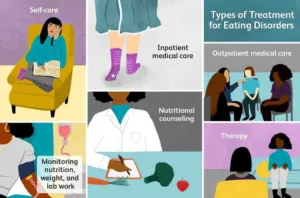Understanding the 10 Types of Mental Disorders
Understanding Eating Disorders Seven of the 10 Types of Mental Disorders
A complicated mental health problem, eating disorders affect people’s interactions with food, eating patterns, and body image. We’ll delve into the nuances of eating disorders in this article, including their numerous varieties, symptoms, possible causes, and accessible treatments. We can help to increasing awareness, fostering empathy, and improving support for people navigating this difficult region by developing a greater knowledge of eating disorders.
What Are Eating Disorders?

A significant mental health disease known as an eating disorder is characterized by erratic eating habits, a mistaken perception of one’s body, and a strong obsession with food and weight. If left untreated, these illnesses can have serious physical and psychological effects.
Types of Eating Disorders
Eating disorders come in a variety of forms, each with particular traits and traits:
1. Anorexia Nervosa
Extreme anxiety over putting on weight and a continuous quest for thinness are characteristics of anorexia nervosa. Anorexics frequently reduce their dietary intake, which causes substantial weight loss and malnutrition.
2. Bulimia Nervosa
Cycles of binge eating followed by purging behaviors, such as vomiting, excessive exercise, or the use of laxatives, define bulimia nervosa. Bulimics may be of normal weight or maybe slightly overweight.
3. Binge Eating Disorder (BED)
BED is characterized by recurring episodes of eating a lot of food quickly while also feeling out of control. Individuals with BED do not regularly purge, in contrast to those with bulimia.
4. Avoidant/Restrictive Food Intake Disorder (ARFID)
ARFID is characterized by a restricted food repertoire because to sensory sensitivity, choking fears, or other aversions. Weight loss and nutrient deficits are potential consequences of this illness.
Advertisement
Symptoms of Eating Disorders
Eating disorder symptoms can appear in a variety of ways, such as:
- Extreme Weight Changes: Significant weight loss or gain brought on by bingeing and purging or restricted eating.
- Food Preoccupation: Constantly worrying about calories, food, and how you look.
- Unhealthy Eating Habits: Engaging in extreme dieting, fasting, or purging behaviors.
- Body image distortion: Perceiving oneself as overweight even when one is underweight.
Potential Causes and Risk Factors

Eating disorders have a variety of root causes, some of which include:
- Genetics: Risk may be increased by a family history of eating problems.
- Psychological Factors: Perfectionism, low self-esteem, and body dissatisfaction play a role.
- Social and Cultural Factors: Societal pressures to meet unrealistic body standards contribute.
- Biological Factors: Brain chemistry and neurotransmitter imbalances may be involved.
Treatment Options
With the proper care and assistance, eating disorders can be recovered from:
- Therapy: People can resolve erroneous ideas and behaviors with the use of cognitive behavioral therapy (CBT), dialectical behavior therapy (DBT), and family-based therapy.
- Nutritional Counseling: Registered dietitians can assist in normalizing eating patterns and promoting a healthy relationship with food.
- Medical Monitoring: In serious situations, medical personnel may keep an eye on a patient’s physical well-being and take action to stop consequences.
Advertisement
Advertisement
Conclusion
The term “eating disorders” refers to a broad spectrum of illnesses that can seriously harm both a person’s physical and mental health. We can provide a more understanding and educated environment for persons facing these difficulties by having a better awareness of the many forms, symptoms, and probable causes of eating disorders. Reducing stigma and assisting people on their path to recovery require taking important measures including seeking professional assistance, encouraging candid dialogues, and promoting body acceptance.




Pingback: What Are the 10 Types of Mental Disorders - AFitHelp
Your comment is awaiting moderation.
Прокуратор с ненавистью почему-то глядел на секретаря и конвой. обзор популярных досок объявлений в хадыженске А может быть, галлюцинировал… Через несколько минут грузовик уносил Рюхина в Москву.